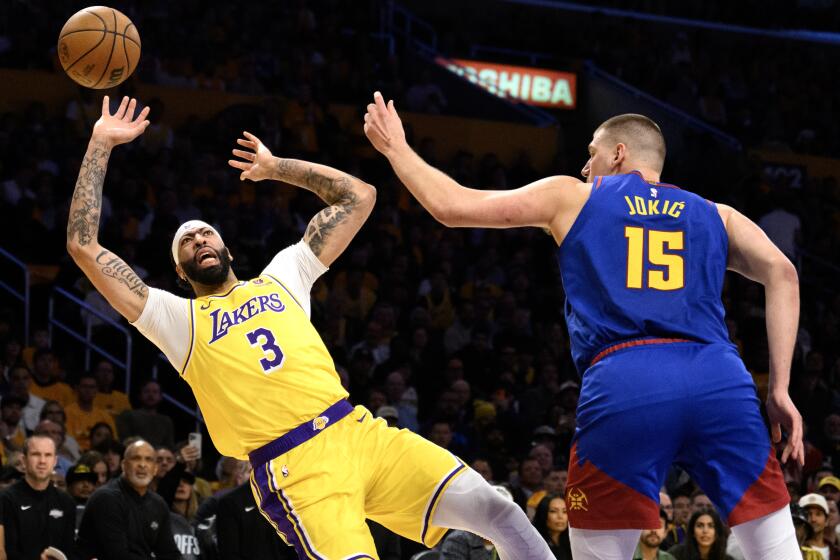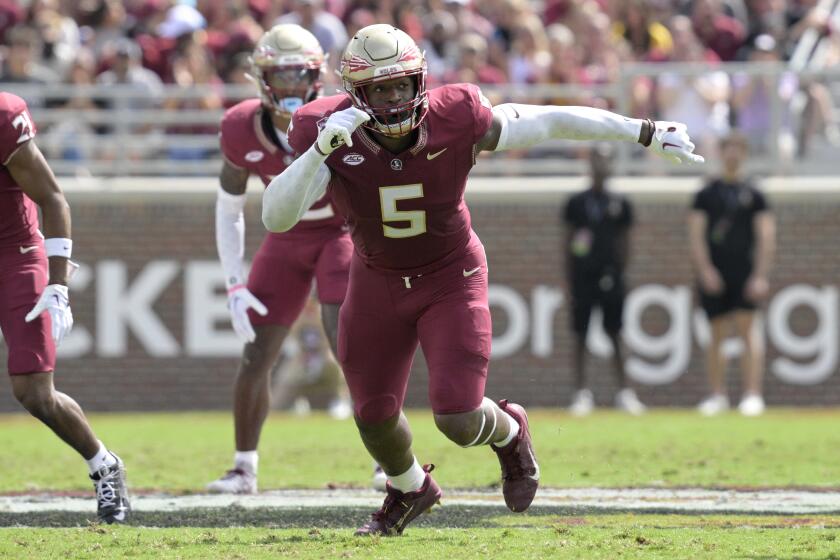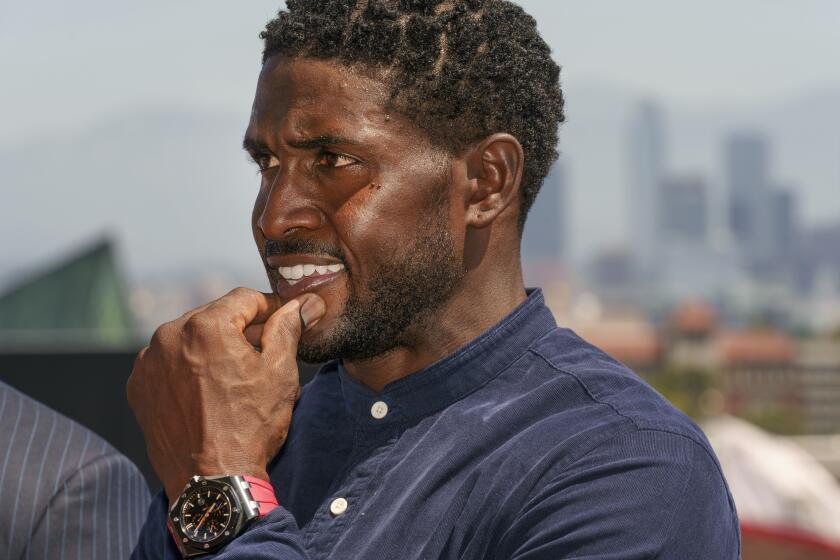Soccer newsletter: Germany is the place to be if you are a young U.S. player
Hello, and welcome to another edition of the L.A. Times soccer newsletter. I’m Kevin Baxter, The Times’ soccer writer, and we begin today with the country that is currently giving more U.S. players a chance to play than any other: Germany.
That’s became MLS is still idle, of course – more about that in a minute – while the Bundesliga and Bundesliga 2 are the only top European leagues to have returned from the COVID-19 pause. Nineteen Americans are on teams that played games in Germany last weekend, although just eight of them made appearances.
But of those eight, six have had a call-up to the national team and four of them are under 22 years of age. So while the rest of the world is sitting and waiting, many of the top young talents in U.S. coach Gregg Berhalter’s player pool are gaining valuable experience, even if they’re doing so in empty stadiums. (More about that in a minute, too.)
“The Bundesliga and German teams in general have fully supported U.S. players and American players,” said Brian McBride, a former national team forward and now the team’s general manager. “Certainly day-to-day training is at a higher level. The competition generally is at a higher level. And that’s a benefit for our players.
“The more we can get players in the European conditions where they are competing against top-level players day in and day out, it’s only going to benefit the players and our national team program.”
Enjoying this newsletter? Consider subscribing to the Los Angeles Times
Your support helps us deliver the news that matters most. Become a subscriber.
Among those who recently made that jump up in class is midfielder Tyler Adams, who left the New York Red Bulls for sister club Leipzig 17 months ago. Injuries have caused him to miss more games than he’s played since then, but he did start and go 68 minutes in his team’s draw with Freiburg last week in Leipzig’s first game in more than two months. Last Sunday he played 30 minutes off the bench a 5-0 win at Mainz.
“The attraction is mainly because you see a lot of teams in the Bundesliga that are willing to play young players and take risks in helping them develop,” Adams, 21, said of Germany’s allure for young Americans. “At least that’s why I wanted to come to Germany.”
The trend is nothing new. Hungarian-born midfielder Andy Mate, who had one cap with the national team, may have been the first U.S. player to go to Germany, making eight appearances with Hamburger SV in 1964-65. More than 50 have followed -- including Berhalter, who played nearly 200 games for FC Energie Cottbus and 1860 Munich.
A teenage Landon Donovan made his professional debut for Bayer Leverkusen in 2000 before homesickness, among other factors, brought him back to the U.S., where he became the most decorated player in MLS history. A few years before that Eric Wynalda, in the prime of his career with the national team, played in Germany.
In the 2014 World Cup, Jurgen Klinsmann used seven players with Bundesliga connections, then two years later he gave Borussia Dortmund’s Christian Pulisic his first start with the national team.
One reason for the long, positive relationship could be playing styles. The strength of U.S. players has typically been determination and athleticism rather than technique or tactical awareness and German clubs have proven willing to accept the challenge of taking those rough stones and trying to polish them into diamonds – especially if they come at young age. The traditional Bundesliga philosophy – fast-paced and heavy in transition – also suits U.S. players.
It’s easier for young Americans to qualify for work permits too. To play in the English Premier League, for example, non-EU residents must have played in a certain percentage of senior national games; Germany has no such restrictions.
“There’s a few factors,” said McBride, who visited a number of national team players in Germany before the spread of COVID-19 forced the league to shut down in early March.
“Look at the amount of scouts that the Bundesliga teams put in the United States so they can see players at younger ages. There’s a work permit issue. But moreso I think it comes down to the fact that Americans have done well in the Bundesliga. And the Bundesliga understands that there is a wealth of talent that maybe they could find at a younger age and bring in, which is beneficial to everybody.”
Signing young American players is cheaper too. Rather than paying a huge transfer fee, Leipzig brought Adams over from MLS on loan then signed him to a contract extension through 2025; the savings allow the team to spend nearly $80 million on other players this season. Pulisic came to Borussia Dortmund for free in 2015 then moved to Chelsea on a $73-milllion transfer four years later
What the players receive in return may be even more valuable though.
“There’s so many different things they can gain,” McBride said. “It’s a different setting so you’re put under different pressure. But on top of that there’s a growth that happens when you go through a change.
“The change of language, the change of setting, being put in an uncomfortable position. If you can get through those moments, it makes you a stronger player, makes you a stronger person.”
Adams can testify to that. Although he said his transition was easier than many because he plays for a team with a lot of English speakers, that doesn’t help away from the field.
“For your everyday life, if you don’t learn German here, I would say that you’re going to struggle,” said Adams, who is studying the language with the help of a tutor. “Whether you’re at a grocery store, being able to navigate your way around the city, things like that are very important.”
More challenging was the two-month coronavirus break from the soccer, one in which Adams was largely confined to his apartment. That was followed by a gradual return to training in small groups while observing strict social-distancing guidelines.
“It was definitely an uncertain time,” he said. “When you’re stuck at home you’re not able to socialize with anyone.”
But if the move to Germany has been a challenge, Adams believes it’s one that can only make him stronger.The sound of silence
Fearing a renewed breakout of COVID-19, the German government has forced the Bundesliga to play its games in empty stadiums. And two weeks into the renewal of play, that appears to be having an impact on the results.
Last season, home teams lost just 95 times in 306 Bundesliga games. This season home teams had lost 83 of 225 games prior to the COVID-19 break.
But since the season resumed, home teams are 3-10-5 in two weeks, which apparently confirms what seems obvious: the support of the home fans has an impact on how the players play and, less obviously, how the officials officiate.
That theory will be tested again Tuesday morning when Borussia Dortmund welcomes Bayern Munich, the only team it trails in the table. Few teams get a bigger boost at home than Dortmund, which plays before the Yellow Wall, so-named for the mass of fans in yellow Dortmund shirts that pack the stands. The South Bank of the Signal Iduna Park has a capacity of 24,454, making it the largest standing terrace in Europe and it is an intimidating site for both opponents and referees, which has a lot to do with the fact Dortmund has lost just once at home in the last two seasons.
This could be a trend worth watching in MLS, which hopes to resume playing home games, most likely in empty stadiums, this summer. In the last two seasons, the visiting team has won just 109 of 421 regular-season games in MLS – a percentage more favorable to the home team than the one in Germany. LAFC, playing in front of its vocal 3252 supporters section – which takes its inspiration from the Yellow Wall -- has lost just twice in 36 regular-season games at Banc of California Stadium.
The Galaxy were hoping for similar help from its north stand, the newly christened Victoria Block, this season. But if the early results from Germany are any indication, the home field may not be an advantage if the stands are empty.
If MLS plan washes out, it won’t be because of leaks
MLS continues to negotiate with its players union in search of a compromise that would allow the league to go forward with its plans to resume play with a round-robin tournament in Florida. But the plan, which calls for all 26 teams to be quarantined in a Disney resort in Orlando for as long as 10 weeks, has gotten a lot of pushback from the union.
We know all this thanks to The Athletic, the website whose reporting on the Orlando proposal and the discussions surrounding it has been so accurate and detailed, MLS commissioner Don Garber last week sent a memo to league and club personnel threatening disciplinary action and fines up to $1 million against anyone leaking information to the media.
A couple of days later The Athletic posted a leaked copy of Garber’s anti-leak memo in which the commissioner goes on to say MLS is working with an investigative firm to determine the source of leaks. This again according to a copy of the memo leaked to The Athletic.
Note that Garber never questioned the accuracy of the reporting, just its existence.
MLS has typically been as transparent as concrete, a stance which does not serve it well when it is compared to the NBA or Major League Baseball, leagues with which MLS has repeatedly said it wants to be compared. The problem is MLS won’t be treated as a major league until it starts acting like one and Garber’s threat to use fines, disciplinary action and private gumshoes to keep its fans in the dark won’t help in that regard.
Garber’s frustration in this case stems from the fact he’s playing a high-stakes game of poker under difficult circumstances with what is proving to be a poor hand. And he may have been dealt something of a trump card recently when three of his league’s biggest stars – LAFC’s Carlos Vela, the Galaxy’s Javier “Chicharito” Hernández and Portuguese star Nani, who plays for Orlando City – said they don’t want to be quarantined. Vela and Hernández have both recently announced their wives are pregnant with their second child.
If Garber goes forward with the proposed Disney tournament without his biggest stars, it would make the event less compelling, both on the field and on television. And if Vela, Chicharito and Nani aren’t penalized for skipping the Orlando games, what’s to prevent other players from boycotting it too?
If MLS does punish its three stars, however, it runs the risk or either alienating or losing them altogether, something that could come back to bite Garber should the league, as he hopes, resume its regular season in each team’s home market later this year. Would he rather have an unhappy Vela and Chicharito for a five-game summer television series in Orlando or for as many as 10 home games in Southern California this fall – and beyond?
Disney, which owns ESPN, has offered to let the league take over one of its signature resorts and play its games behind closed doors at ESPN’s Wide World of Sports in exchange for the right to broadcast the matches. It’s a win-win for both Disney – which needs to fill both its empty resorts and ESPN’s vacant programming schedule – and the league, which desperately wants to be the first professional league in North America to resume play.
Exactly how to make that happen has proven difficult. According to The Athletic and other reports, the league wants to bring its teams to Florida next month and lock them up in the Coronado Springs resort for as long as 2 ½ months, with no access to friends or family members.
Players would be tested for COVID-19 starting 72 hours before leaving for Orlando and would retested repeatedly while in Florida. Anyone who tested positive would be isolated from the rest of the group.
The 26 teams would arrive in Orlando early next month and, when the tournament started, would be separated into three groups of six teams and one eight-team group. They would play five games in the group stage – results that would count toward the regular-season MLS standings should the season, suspended in March after two games, be resumed – with the top two teams in each group advancing to an eight-team knockout stage.
The biggest issue dividing the players and the league is the quarantine, with the union asking why resort staff, the employees who are cleaning their rooms and making their food, are safe to leave and return each day but the players aren’t.
As part of the negotiations the league, several leaked reports have said, proposed huge reductions to player salary and bonuses. MLS has also slow-walked ratification of the collective-bargaining agreement it agreed to with the players last winter, which The Athletic said might allow teams to lock the players out, leaving them without salaries or health insurance.
The players made a counterproposal on the wage and bonus issues, suggesting there is ample desire for a compromise if the quarantine questions can be solved. Whether the answers to those questions are enough to win over Vela, Chicharito and Nani remains to be seen.
Expect the answers to be leaked soon.
They have a right to feel a little azul
By some counts Mexico City’s Cruz Azul is the third-most-popular club in Mexico and its fans have been among the most loyal and long-suffering since the team hasn’t won a league title this century. So it seemed particularly cruel that Liga MX chose May 22, the 93rd anniversary of the club’s founding, to cancel the rest of the season with Cruz Azul atop the table after 10 of its scheduled 17 games.
No champion will be crowned for the first time in league history, extending Cruz Azul’s title drought to 23 years.
Although the league suspended play March 15 some teams had begun testing players for the novel coronavirus with an eye toward resuming the schedule. But when a dozen players from Santos, based in the northern city of Torreón, tested positive for COVID-19, the league decided to shut down.
Top of their class
The UCLA’s women’s team made it to the final four of the NCAA tournament twice in last three seasons. And coach Amanda Cromwell has put together an equally impressive streak in recruiting, with Top Draw Soccer ranking the Bruins’ 2020 class No. 1 in the country.
Top Drawer ranked UCLA’s 2019 class second in the nation.
Half the 14 players to sign with UCLA this year are U.S. youth national team veterans: Aislynn Crowder, Isabel Loza, Jillian Martinez, Michaela Rosenbaum, Dasia Torbert, Reilyn Turner and MacKenzee Vance. Cromwell also landed youth national players from Canada, Norway and Sweden, respectively in Kaila Novak, My Haugland Sorsdahl and Clara Hardling.
“This group of players is committed to the culture of excellence that defines UCLA,” Cromwell said in a statement. “They have represented their countries and club teams at the highest level and are now ready to bring that experience to Westwood and make an immediate impact in our program and around our university. This class adds immense talent and depth to our team.”
The new recruits will join a team that includes four talented sophomores-to-be in forwards Mia Fishel and Kali Trevithick, midfielder Rachel Lowe and defender Brianne Riley. Fishel led the team with 14 goals as a freshman. The Bruins are also expected to have Hawaii’s Sunshine Fontes, the top recruit from 2019, available next season.
Fontes, the all-time leading scorer for the U-17 national team, sat out last season with a torn ACL.
Gone are co-captains Jessie Fleming, a midfielder, and Teagan Micah, a goalkeeper; forward Chloe Castaneda; and defender Kaiya McCullough, a foursome that led UCLA to a 69-16-8 record and a berth in the 2017 national championship game in their four seasons in Westwood.
Junior forward Ashley Sanchez has also left to join the NWSL after leading the team with 15 assists in 2019.
Podcast
Don’t miss my weekly podcast on the Corner of the Galaxy site as co-host Josh Guesman and I discuss the Galaxy each Monday. You can listen to the most recent podcast here.
Quotebook
“Playing matches without supporters is sadder than dancing with your sister.”
Spain national team coach Luis Enrique, on watching the Bundesliga return behind closed doors
Until next time...
Stay tuned for future newsletters. Subscribe here, and I’ll come right to your inbox. Something else you’d like to see? Email me. Or follow me on Twitter: @kbaxter11.
Get our high school sports newsletter
Prep Rally is devoted to the SoCal high school sports experience, bringing you scores, stories and a behind-the-scenes look at what makes prep sports so popular.
You may occasionally receive promotional content from the Los Angeles Times.




